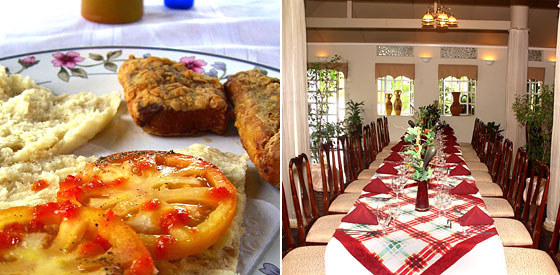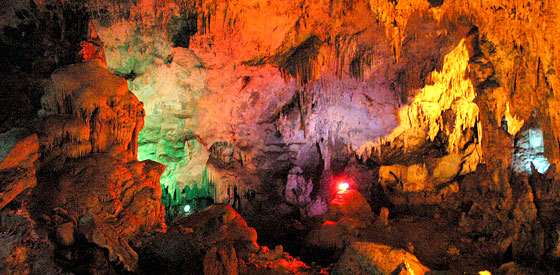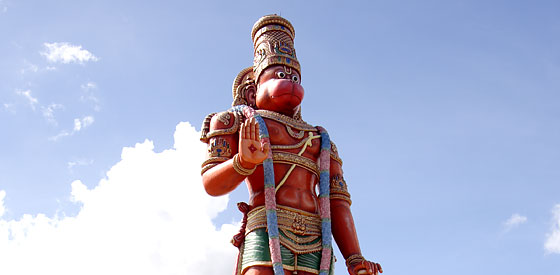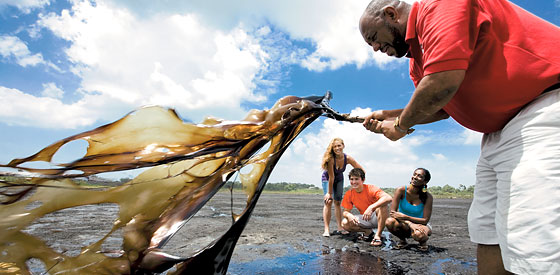1. Where to Stay

Until the Hyatt Regency Trinidad (from $299) opened in January 2008, Port-of-Spain’s hotels had largely lost their shine. The high-end waterfront hotel has an infinity pool, world-class spa, and open-air dining. Request a gulfside room and say hello to Venezuela, visible just seven miles away.
Get a Tarzan B&B vibe from Pax Guest House (from $50), the island’s oldest inn. Part of a 600 acre Benedictine monastery complex surrounded by rainforest on the Northern Range, Pax is just 25 minutes from downtown and the airport. The dinner buffet is a convivial serenity-breaker.
Chaconia Hotel (from $125) in upscale Maraval is a central base for both Port-of-Spain and the Northern Ridge’s rain forests and beaches. The Mediterranean architecture is tricked out with Trinidadian décor, and the secluded pool terrace is an excellent reminder that you’re on vacation in the Caribbean.
2. Where to Eat

The food stalls along Western Main Road in the St. James neighborhood start serving early in the morning and continue well into the night; look for the colorful tents and long lines. “Doubles” are the local favorite: spicy curried chickpeas served with tamarind sauce and chutney between two doughy dumplings. Even fans of fiery heat should ask for only “slight pepper.” Mere mortals should request “no pepper.”
Bake ‘n’ Shark is marinated shark meat deep-fried to order, stuffed into fried dough and topped by your choice of several dozen condiments. You’ll find Trinidad’s national dish just about everywhere, but loyalists swear by Richard’s shack on Maracas Beach, the sandwich’s birthplace. Richard’s is the one with the epic line.
When you’re ready for a proper sit-down, join Port-of-Spain’s growing crowd of foodies at Mélange (40 Ariapita Ave.; 868-628-8687). Owner and chef Moses Ruben incorporates classic Trini ingredients such as cassava into his changing menu of international offerings. Reservations aren’t required, but be aware that most restaurants tack on a 10 percent service charge.
3. What to Do

Catch a boat leaving from a dock near the Hyatt Regency and cruise among the four narrow straits of Bocas del Dragón that separate Trinidad and Venezuela. Hop among several small islands in the channels: swim the coves at Monos and Chacachacare and spelunk the limestone Gasparee Caves (beware of fruit bats) on Gaspar Grande. Find other tour boats at the Trinidad and Tobago Yacht Club and the Trinidad and Tobago Yacht Association, both located in Chaguaramas, a straight shot west of Port-of-Spain by way of Wrightson Road.
Make a reservation to visit the nonprofit Asa Wright Nature Centre, a former coffee, cocoa, and citrus plantation. Take a walk with a naturalist through the protected rain forests of the Northern Range (10:30 a.m. and 1:30 p.m.; included in $10 admission fee) or book a more strenuous bird- and turtle-watching excursion with Caligo Ventures.
Hear a steel-drum band rehearse in the Laventille Panyards (off Old St. Joseph Road). The groups compete every year during Panorama, the steel pan Super Bowl equivalent held during Carnival, but the outdoor practices are open to the public. Schedules vary, so ask your hotel clerk or a cabbie for more information.
4. Insider’s Tip

Take a “maxi taxi” (a privately operated minivan shuttle) or a driver (about $50) to Dattatreya Ashram in Carapichaima, central Trinidad. There, you’ll find the Western Hemisphere’s largest statue of Lord Hanuman. The buff monkey god stands 85 feet tall and is a towering reminder of the island’s Hindu ancestry—fully half of Trinidadians can trace their bloodlines back to India .
5. Oddball Day

Heal thyself during a day trip to Trinidad’s southwest corner, home to two unusual geological formations believed to have medicinal properties. Maxi taxis run regularly from the capital to Chaguanas; look for the green markers on the side. From Chaguanas, shuttles then run to San Fernando, a good rally point for the day. Or, hire a private driver for the day ($50–$100). The Pitch Lake (in La Brea) has been sealing the world’s cracks since Sir Walter Raleigh waterproofed his ship here in the sixteenth century. From La Brea, Spanish for “tar,” between 180 and 240 tons of asphalt are extracted each day. Visitors will be more interested in the lake’s legendary ability to heal aching joints and cure sinus troubles. Stop for lunch in Third, Fifth, or Sixth Company villages, so named for the former American slaves who settled here after serving as free men in the War of 1812—on the British side. Inhale the vapors at the Devil’s Woodyard, a few miles inland in Princes Town. The mud volcano is a natural rarity, prone to covering entire villages in thick, foul-smelling muck—tiny nearby Piparo was buried under tons of the stuff in 1997. European settlers likened the subterranean rumblings to Satan stockpiling kindling, but the vapors will at least clear your sinuses.
6. Links
Get a colorful briefing from the Trinidad and Tobago News Blog.
Check the food glossary on Simply Trini Cooking before you order.
A British-Candian expat blogs about her life in Trinidad on 3limes.